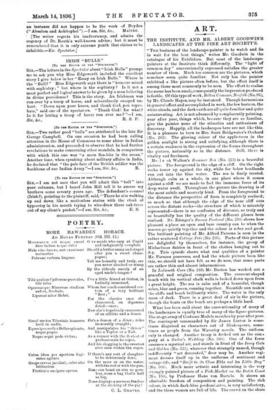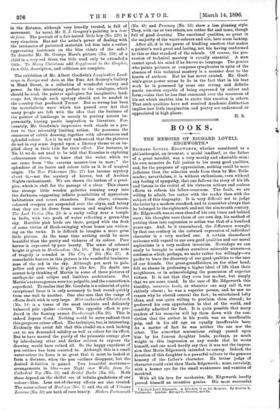ART.
THE INSTITUTE, AND MR. ALBERT GOODWIN'S LANDSCAPES AT THE FINE ART SOCIETY'S.
"THE business of the landscape-painter is to watch and lie in wait for the best things," writes Mr. Goodwin in the catalogue of his Exhibition. But most of the landscape- painters at the Institute think differently. The "light of common day" conventionally expressed satisfies the greater number of them. Much too common are the pictures, which somehow seem quite familiar. Not only has the painter exhibited a like picture often before, but the effect itself is among those most commonly to be seen. The effort to realise the scene has been small, consequently the impression produced
is feeble. Of this type of work, Belton Common, Norfolk (No. 95), by Mr. Claude Hayes, may be instanced. Though harmonious
in general effect and accomplished in work, the low horizon, the white clouds, and the dark earth are all quite familiar and quite uninteresting. Art is not advanced by complacently painting, year after year, things which, because they are so familiar, give the painter none of the stimulus and enthusiasm of discovery. Happily, all the landscapes here are not like this.
It is a pleasure to turn to Mrs. Scott Bridgwater's Orchard
(No. 202). The glowing colour of the apple-trees in the golden sunlight is strong and satisfying, although there is
a certain weakness in the expression of the forms throughout the picture, noticeably so in the distance. Still, there is vitality and freshness.
Mr. .1 r uk Walton's Summer Sea (No. 223) is a beautiful picture. The foreground is the edge of a cliff. On the right
rocks tower up against the sky, while far below headlands
run out into the blue water. The sea is finely treated. Although calm as a whole, in one place where it comes
against a cliff we are made to feel the immense force of ita deep-water swell. Throughout the picture the drawing is of the most subtle and masterly kind. From the foreground to the distance the perspective of form is completely realised; so much so that although the edge of the near cliff cuts across the distant rocks—the structure of which is minutely represented—there is no confusion of distance, so truly and
so beautifully has the quality of the different planes been realised. Mr. Edinger's Sussex Pastoral (No. 210) shows how
pleasant a place an open and bare country can be when the masses go quietly together and the colour is sober and good. The brilliant painting of Mr. Alfred Parsons is seen in the
rather scattered Cottage Pets (No. 235). Parts of this picture
are delightful by themselves, for instance, the group of Michaelmas daisies in front of the clothes banging out to dry. This episode shows what real qualities of a painter Mr. Parsons possesses, and had the whole picture been like this, we should not have felt as we do now, that some parts are rather thin and almost inharmonious.
In Lultoorth Cove (No. 249) Mr. Burton has worked out a. graceful and original composition. The crescent-shaped
beach with its vertical chalk walls is looked down upon from
a great height. The sea is calm and of a beautiful, though sober, blue and green, running together. Noontide sun makes the cliffs and beach brilliantly white. The water is the only mass of dark. There is a great deal of air in the picture, though the boats on the beach are perhaps a little hard.
What has been said about the conventionality of many of the landscapes is equally true of many of the figure-pictures.
The stage-army of Costume Models marches by year after year. The contingent commanded by Sir James Linton is some- times disguised as characters out of Shakespeare, some- times as people from the Waverley novels. The uniform only is changed. Another troup is decked out as the com-
pany at a Sailor's Wedding (No. 348). One of the force assumes a mystical air, and stands in front of the Ivory Gate and Golden (No. 521), whatever that strangely named, though indifferently "art decorated," door may be. Another regi- ment dresses itself up in the uniforms of sentiment and nottage-life, and "Swift to its Close Ebbs out its Little Day" (No. 505'. Much more artistic and interesting is the very -arongly painted picture of a Fish-Market on the Dutch Coast
(No. 150), by Professor Hans von Bartels. It shows an admirable freedom of composition and painting. The rich colour, in which dark-blue predomiaates, is very satisfactory, and the three women are fall of life. The crowd on the shore in the distance, although very broadly treated, is fall of movement. As usual, Mr. E. J. Gregory's painting is a tour de force. The portrait of a fair-haired little boy (No. 229) is very vivacious. Has not the artist's power of dealing with the intricacies of patterned materials led him into a rather aggravating insistence on the blue chintz of the sofa ? To describe Mr. St. George Hare's picture (No. 159) of a child in a very red dress, the title need only be extended a little. To Merry Christmas add Supplement to the Graphic, then title, description, and criticism are complete.
The exhibition of Mr. Albert Goodwin's Imaginative Land- scape in Europe and Asia, at the Fine Art Society's Gallery in Bond Street, is a collection of wonderful variety and power. In the interesting preface to the catalogue, which should be read, the painter apologises for imaginative land- ecape Art, though such apology should not be needed in the country that produced Turner. But so strong has been the materialistic wave which has passed over Art that many people are left with the idea that the business of the painter of landscape is merely to portray nature im- personally, leaving poetic inspiration to literature. For- tunately, Mr. Goodwin's impressive work stands as a pro- test to this miserably limiting notion. He possesses the resources of subtle drawing, together with adventurous and splendid colour. LA it be well understood that the pictures do not in any sense depend upon a literary theme or an im- plied story in their title for their effect. For instance, in No. 15 we do not need to be told that Rasselas is exploring subterranean rivers, to know that the water which we see came from " the caverns measurc less to man ; " the splendour of its lustre and colour tells us it is of magical origin. The Tree Fishermen (No. 27) has intense mystery about it,—not the mystery of horror, but of Arabian Nights enchantment. We are shown the bottom of a preci- pice, which is cleft for the passage of a river. This chasm has strange little wooden galleries running away into the darkness, suggesting infinite possibilities of mysterious habitations and secret chambers. From above, crimson- coloured creepers are suspended over the abyss, and betray that they are let down from unseen and magical forests. The Last Victim (No. 23) is a rocky valley near a temple in India, with two pools of water reflecting a green-blue sky. Horrible pink birds are there, gorged with the flesh of some victim of Hook-swinging whose bones are whiten- ing on the rocks. It is difficult to imagine a more grim little picture. At the same time nothing could be more beautiful than the purity and richness of its colour. Pure horror is expressed by pure beauty. The sense of colossal height is given in Heathendom (No. 19). But a. deeper note of tragedy is sounded in The City of Via (No. 47). A remarkable feature in this picture is the wonderful luminous- ness of the red in the sky. Although put next to pale- yellow and pure white, it glows like fire. No doubt one cannot help thinking of Martin in some of these pictures of earthquake and eclipse and limitless architecture. But Martin's extravagances were too palpable, and the connection is superficial. To realise that Mr. Goodwin is a colourist of quite exceptional force it is only necessary to look round quickly from one wall to another. One also sees that the range of effects dealt with is very large. Mist-enshrouded Christchurch (No. 14) is a tissue of the most intricate and delicately balanced pale opaline colours. The opposite effect is pro- duced in the flaming sunset Ba»zborough (No. 20). This is indeed Joyous Gird. Nothing could be more radiant than this gorgeous colour effect. The technique, too, is interesting. Evidently the artist felt that this citadel on a rock looking out to sea demanded solidity as well as colour for its effect. But to have marred the purity of the prismatic orange glow by introducing other and darker colours to express the drawing would have ruined all. So the happy expedient of pen outlines has been resorted to. Although this is a small water-colour its force is so great that it must be looked at from a distance, when the pen outlines disappear, but the desired drfinition is gained. Two beautiful nocturne— arrangements in blue —are Night over Wells, from the Cathedral Top (No. 55) and Bristol Docks (No. 63). Both these depend on the skilful use of infinite gradations of one colour—blue. Less out-of-the-way effects are also treated. The water-colour of Hastings (No. 1) and the oil of Vitznau Lucerne (No. 30) are both of rare beauty. Modern Portsmouth (No. 49) and Pevensey (No. 51) show a less pleasing style They, with cne or two others, are rather flat and tame, though full of good drawing. The emotional qualities, so great in the majority of the water-colours and oils, here seem lacking.
After all, it is the power of kindling emotion that makes a painter's work great and lasting, not his having conformed to this or that standard of the schools. Of course, the pos- session of technical mastery is equally essential. A man cannot speak his mind if he knows no language. The genius who paints pictures or composes symphonies in spite of the absence of this technical mastery is a monster dear to the hearts of authors. But he has never existed. Mr. Good- win's great power seems to lie in the fact that in his best work he is possessed by some one strong and definite poetic emotion capable of being expressed by colour and form ;—also that he has that command over the resources of his art which enables him to excite this emotion in others. That such qualities have not received Academic distinction implies how little imagination and poetry are understood or appreciated in high places. H. S.







































 Previous page
Previous page